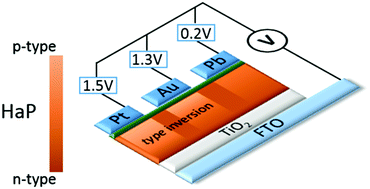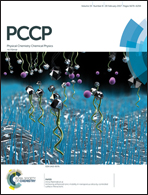Type-inversion as a working mechanism of high voltage MAPbBr3(Cl)-based halide perovskite solar cells†
Abstract
Using several metals with different work functions as solar cell back contact we identify majority carrier type inversion in methylammonium lead bromide (MAPbBr3, without intentional doping) as the basis for the formation of a p–n junction. MAPbBr3 films deposited on TiO2 are slightly n-type, whereas in a full device they are strongly p-type. The charge transfer between the metal electrode and the halide perovskite (HaP) film is shown to determine the dominant charge carrier type of the HaP and, thus, also of the final cells. Usage of Pt, Au and Pb as metal electrodes shows the effects of metal work function on minority carrier diffusion length and majority carrier concentration in the HaP, as well as on built-in voltage, band bending, and open circuit voltage (VOC) within a solar cell. VOC > 1.5 V is demonstrated. The higher the metal WF, the higher the carrier concentration induced in the HaP, as indicated by a narrower space charge region and a smaller minority carrier diffusion length. From the analysis of bias-dependent electron beam-induced currents, the HaP carrier concentrations are estimated to be ∼ 1 × 1017 cm−3 with Au and 2–3 × 1018 cm−3 with Pt. A model in which type-inversion stretches across the entire film width implies formation of the p–n junction away from the interface, near the back-contact metal electrode. This work highlights the importance of the contact metal on device performance in that contact engineering can also serve to control the carrier concentration in HaP.

- This article is part of the themed collection: 2017 PCCP HOT Articles


 Please wait while we load your content...
Please wait while we load your content...